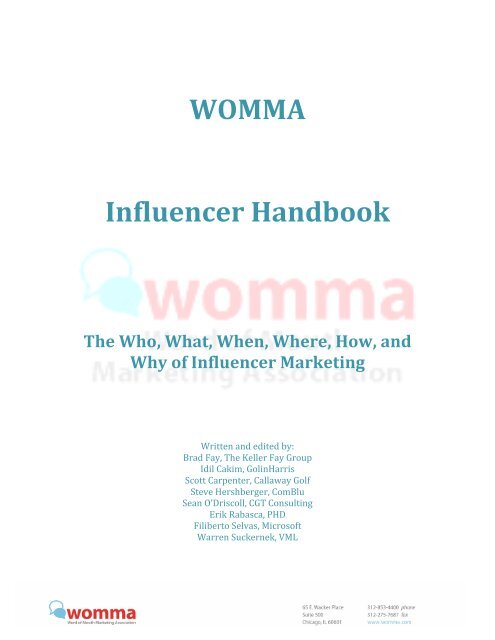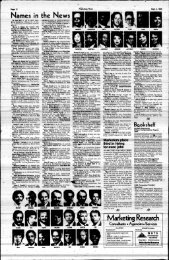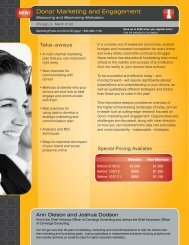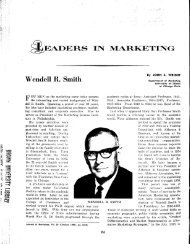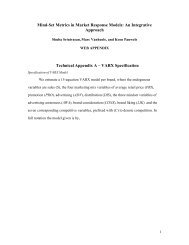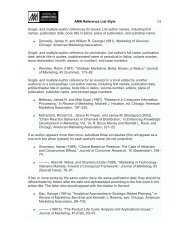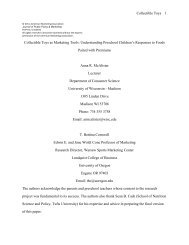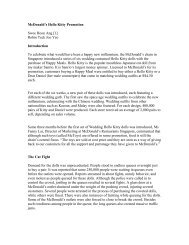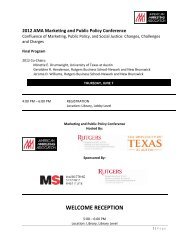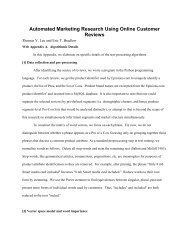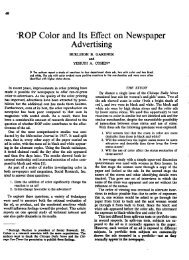Influencer Handbook FINAL - American Marketing Association
Influencer Handbook FINAL - American Marketing Association
Influencer Handbook FINAL - American Marketing Association
You also want an ePaper? Increase the reach of your titles
YUMPU automatically turns print PDFs into web optimized ePapers that Google loves.
<br />
<br />
WOMMA <br />
<br />
<br />
<strong>Influencer</strong> <strong>Handbook</strong> <br />
<br />
<br />
<br />
The Who, What, When, Where, How, and <br />
Why of <strong>Influencer</strong> <strong>Marketing</strong> <br />
<br />
Written and edited by: <br />
Brad Fay, The Keller Fay Group <br />
Idil Cakim, GolinHarris <br />
Scott Carpenter, Callaway Golf <br />
Steve Hershberger, ComBlu <br />
Sean O’Driscoll, CGT Consulting <br />
Erik Rabasca, PHD <br />
Filiberto Selvas, Microsoft <br />
Warren Suckernek, VML
<strong>Influencer</strong> <strong>Marketing</strong> Defined<br />
The Word of Mouth <strong>Marketing</strong> <strong>Association</strong> defines an influencer as:<br />
A person who has a greater than average reach or impact through word of<br />
mouth in a relevant marketplace<br />
WOMMA defines <strong>Influencer</strong> <strong>Marketing</strong> as:<br />
<strong>Influencer</strong> marketing is when a marketer identifies, seeks out, and engages<br />
with influencers in support of a business objective.<br />
Types of <strong>Influencer</strong>s<br />
Academics and marketers have been talking about influencers for more than five<br />
decades, going back at least to 1955 when Paul Lazarsfeld and Elihu Katz wrote<br />
about a “two-step” communication process in their landmark work, Personal<br />
Influence (Free Press). Their concept, which has stood the test of time, is that<br />
some people have a disproportionate degree of influence on others and can be<br />
effective communications channels.<br />
Like word of mouth marketing itself, influencer targeting can come in many forms<br />
-- differences in who they are, how they are reached, and what they are called.<br />
While it would probably be impossible to inventory every conceivable type or<br />
name, what follows is a framework that demonstrates the diversity of targeting<br />
options for influencer marketing. Whether aiming at the highest ranking, formal,<br />
or institutional leaders, prominent talking heads in the media, grassroots<br />
influencers on the internet, or influencers in your neighborhood, all types of<br />
influencers can provide the basis for an influencer marketing strategy.<br />
In the table below, we identify five broad categories of influencers based on<br />
varying degrees of formal/institutional roles to less formal influencers whose<br />
value stems from more personal characteristics -- social networking, personality,<br />
and inclination to share opinions. Numerous researchers and marketers have<br />
developed names -- some trademarked -- for the various influencer types.<br />
2
Category Who they are Channels of<br />
influence<br />
Formal Political/government Laws & regulations<br />
position of leaders/staff<br />
Decision & spending<br />
authority Business leaders authority<br />
Top-down directives<br />
Institutional/re<br />
cognized<br />
subject matter<br />
experts and<br />
advocates<br />
Academics/scientists<br />
Industry analysts<br />
NGO leaders<br />
Consumer activists<br />
Media elite Journalists<br />
Commentators<br />
Talk show hosts<br />
Cultural elite<br />
Socially<br />
connected<br />
Celebrities<br />
Designers<br />
Artists<br />
Musicians<br />
Neighborhood leaders<br />
Members of<br />
community groups<br />
Online networkers<br />
Business networkers<br />
Academic journals<br />
Traditional media<br />
New media<br />
Social media<br />
Traditional media<br />
New media<br />
Social media<br />
Traditional media<br />
New media<br />
New styles/products<br />
Social media<br />
Personal relationships<br />
Email lists<br />
Social gatherings<br />
Websites<br />
Social media<br />
3<br />
What they are<br />
called (partial list)<br />
Opinion Leaders<br />
Decision makers<br />
C-suite<br />
Experts<br />
Mavens<br />
Analysts<br />
Critics<br />
Talking heads<br />
Columnists<br />
Politicos<br />
Trendsetters<br />
Fashionistas<br />
Taste makers<br />
Creators<br />
Starters<br />
Mavens<br />
Starters<br />
Connectors<br />
Soccer moms<br />
Spreaders<br />
Hubs<br />
Alphas<br />
Guidelines For Working With <strong>Influencer</strong>s<br />
The following is a set of guidelines assembled by the WOMMA <strong>Influencer</strong><br />
Council. The purpose of these guidelines is to provide a set of best practices for<br />
word of mouth programs that target or include influencers. These guidelines are<br />
written to include the principles and best practices found in WOMMA’s Ethics<br />
Code. The Ethics Code can be found at http://womma.org/membersonly/.<br />
Although following these guidelines is not a requirement for WOMMA members,<br />
doing so will help to ensure program continuity, as well as positive results for<br />
both the brand and the customer.
1. Always abide by the WOMMA Honesty ROI when engaging influencers to<br />
participate in brand marketing activities.<br />
2. Make an effort to listen to and understand an influencer's point of view about<br />
my brand before and during their engagement in a brand program or<br />
marketing activity or simply, in their role as a customer of my brand.<br />
3. Understand the savvy nature of influencers and will commit to personalizing<br />
my invitations for brand participation. I pledge to respect the rights of<br />
influencers as individuals and agree to maintain a level of personalized or<br />
individualized interaction with them separate from automated or masscustomized<br />
communications. Furthermore, I understand that if an influencer<br />
does not reply to my request for participation, I will respect that<br />
individual's privacy and cease to solicit them. Finally, I agree not to share their<br />
personal information without their express permission.<br />
4. Make an effort to build a respectful and open relationship with my brand’s<br />
influencers, where collaboration (instead of expectation) is the guiding nature<br />
of communication. Additionally, I will communicate with influencers in a timely<br />
manner.<br />
5. Ask influencers to transparently represent the source of their information<br />
when communicating about or representing my brand to others, whether on or<br />
offline. I will proactively provide influencers with guidelines for transparency<br />
and actively support this transparency within the company, media, and<br />
marketplace.<br />
6. Invite and respect the opinion of participating influencers, even if this is<br />
contrary to the brand's position. I agree to share or make available these<br />
opinions throughout my organization as is appropriate. Furthermore, I will<br />
allow influencers to evolve or remix messaging so as to be relevant to how<br />
they communicate with their community.<br />
7. Never ask influencers to falsify or "hype" any product claims, make usage<br />
claims without direct experience, or back claims that neither they nor the<br />
brand can substantiate. I will never request an influencer to undertake on my<br />
behalf a task that they are uncomfortable with or do not believe in.<br />
8. Provide incentives for participation in brand programs, I will fully disclose the<br />
nature of the program so as not to give the appearance of a conflict of interest<br />
or shilling. I fully understand that I am not establishing rewards as a payoff for<br />
opinions and am ensuring transparency of any marketing efforts.<br />
9. Don’t manipulate advertising or affiliate programs to impact influencer<br />
involvement or income derived by the brand from influencer programs. I will<br />
not falsely manipulate program findings or influencer opinions in any way, nor<br />
will I manipulate or falsely communicate a program’s progress or result to any<br />
party internal or external.<br />
10. Thank influencers who have participated in brand-initiated programs.<br />
4
How To Work Effectively With <strong>Influencer</strong>s<br />
<strong>Influencer</strong> marketing is about change from marketing “at” consumers to<br />
marketing “with” people. It’s about initiating a relationship based on both give and<br />
take, two-way conversations, and showing appreciation. Once you have<br />
identified appropriate influencers, it is necessary to establish a productive, twoway<br />
relationship. Key hallmarks of such a relationship include giving thanks and<br />
creating true engagement.<br />
Let’s differentiate an influencer program from a loyalty program as a key<br />
assumption. Loyalty programs serve an important role and can be a subset of a<br />
well-designed influencer program, but are by definition less comprehensive in<br />
their approach. Put simply, loyalty programs provide incentives (points, punch<br />
cards, miles, status) for frequent product/service use/affiliation, but typically lack<br />
comprehensive connection and feedback efforts. A loyalty program can be a<br />
good filter for influencer identification, but doesn’t account for the connectedness<br />
of the user or their level of activity in influence behaviors. In order to maximize<br />
the influence effect, it’s necessary for a brand to commit to a set of bi-directional<br />
relationships with influencers.<br />
Given this prerequisite assumption, let’s look a bit further at thanking influencers<br />
and engaging and enabling them.<br />
Thanking Your <strong>Influencer</strong>s:<br />
Identification and segmentation of your influencers is just the first step in a threestep<br />
process recommended for influencer marketing. Step two is an opportunity<br />
for you and your brand to reach out and thank the influentials. As a starting<br />
point, “thanking” is about acknowledgement of their passion, contribution, and/or<br />
usage of your products/services and is designed to establish communication with<br />
the influencer and begin to develop a bi-directional connection between the<br />
influencer and the brand.<br />
The following are recommended guidelines and suggestions based on a<br />
combination of industry practices:<br />
• <strong>Influencer</strong>s aren’t doing what they do to help your brand; they are doing it to<br />
help other users. Thank them for helping other users instead of just for<br />
helping your brand.<br />
• Respect privacy prerogatives. Whatever thanks you are providing, they<br />
should have the right to opt out. If they opt in, this is a good time to gather<br />
contact and sharing rights (share my recognition info with no one, share my<br />
contact info with the brand only, ok to share public, etc.).<br />
• Be cautious about rewards and gifts. While modest gifts are great to share, a<br />
t-shirt will not build brand affinity and is no substitute for an ongoing,<br />
5
committed connection with the user (more on this in the engage<br />
section). More generous gifts may be construed in the wrong way, create a<br />
cost burden you can’t sustain, a tax liability for the influencer, and/or public<br />
backlash for perception of rewarding positive reviews. In extreme cases,<br />
substantial rewards could create an implied co-employment risk with the<br />
influencers. Awards and gifts should only be for what influencers have done in<br />
the past, with no forward-looking expectations on the part of the brand. It’s<br />
better to keep awards simple and relevant to your community objectives.<br />
• Surprises work. Don’t underestimate the power of doing something dramatic<br />
and/or unexpected. Creating legendary stories can be very powerful ways to<br />
both generate conversation and affinity.<br />
• Similar to surprises, moments of truth about product failures are important. If<br />
there is a recall, or you cancel flights - it's how your customer service<br />
responses in these moments that create "sticky memories" for you brand.<br />
Listening to your influencers and responding aggressively is key. The call to<br />
action here: ensure you’ve tuned your listening system to be especially alert<br />
to this audience.<br />
• Your best influencers may not always be positive about your product,<br />
company and/or services. In fact, your biggest fans may at times be your<br />
harshest critics. The fact they are sometimes negative will make them far<br />
more credible to their networks.<br />
Engaging Your <strong>Influencer</strong>s:<br />
Now you’ve found them, and you’ve thanked them. It’s time to engage them. Just<br />
knowing who your influencers are is a step ahead of most organizations today,<br />
but to maximize the value of their role in the network, you need to commit to an<br />
engagement model with them. This is the third, and perhaps the most critical,<br />
aspect of differentiating influencer programs from other loyalty<br />
efforts. Engagement can take a number of different forms depending on your<br />
industry, audience, and business objectives. What follows are some suggestions<br />
on how to get started with engagement.<br />
• Consider engagement as a balance sheet. The relative benefits to you, the<br />
brand, and the influencers needs to be in balance with one another. If the<br />
balance is too much in your favor, your influencers will feel used and you’ll<br />
ultimately alienate passionate users. If the balance is too much in the favor of<br />
your influencers, you’ll lose interest over time, and your program will be a<br />
campaign instead of a multi-year, long-term commitment.<br />
• <strong>Influencer</strong> programs are, by definition, long-term, multi-year commitments<br />
designed to build a relationship; they are not marketing campaigns.<br />
Campaigns can augment influencer efforts to help find, activate, or engage<br />
influencers in particular activities (like a product launch), but influencer<br />
6
programs need to level out the roller coaster of connections provided by<br />
campaigns.<br />
• Private access is an excellent way to engage your influencers. If they are<br />
passionate about your product or service, you can be reasonably sure they<br />
would be passionate about opportunities to connect behind-the-scenes in<br />
your company with the people who make the product or service. Private<br />
access can also be seen as a form of social currency within the influencer<br />
community; it gives them a sense of pride and connection to your brand or<br />
company.<br />
• Likewise, influencers generally love to connect to one another. You can<br />
provide opportunities for private interaction amongst your influencers.<br />
• Consider both online and offline connection opportunities. Online scales and<br />
connects more broadly, but offline creates more powerful and trusting<br />
relationships. Similarly, consider different connection modes: Meetings,<br />
conferences, online chats, webcasts, conference calls, etc. No one solution<br />
fits all or scales equally.<br />
• <strong>Influencer</strong>s are a great source of product feedback. Ideally, design your<br />
influencer marketing program such that you can close the loop back with your<br />
influencers on what you’re doing with their feedback and suggestions. Falling<br />
short of closing the loop substantially diminishes the value of listening in the<br />
first place.<br />
• Transparency. With the possible exception of analysts and partners, this is<br />
the audience you should be most transparent with. They can be your early<br />
warning system for both good ideas and bad ideas.<br />
• Depending on your program and goals, consider a non-disclosure agreement<br />
as part of your process. Bringing influencers closer to your inner circle on<br />
longer-range product plans is key to building loyalty and affinity. It’s<br />
reasonable, depending on your business, to consider a non-disclosure for<br />
some of those private discussions.<br />
7
Resources for further study<br />
Books<br />
Berry, Jon and Keller, Ed. The Influentials: One <strong>American</strong> in Ten Tells the Other<br />
Nine How to Vote, Where to Eat, and What to Buy. New York: Free Press, 2003.<br />
Brown, Duncan and Hayes, Nick. <strong>Influencer</strong> <strong>Marketing</strong>: Who Really Influences<br />
Your Customers. Oxford: Butterworth-Heinemann, 2008.<br />
Cialdini, Robert. Influence: Science and Practice, 5 th Edition. Essex: Allyn and<br />
Bacon, 2001.<br />
Gillin, Paul. The New <strong>Influencer</strong>s: A Marketer's Guide to the New Social Media.<br />
Sanger: Quill Driver Books, 2003.<br />
Gladwell, Malcolm. The Tipping Point: How Little Things can make a Big<br />
Difference. Oxford: Little, Brown, 2003.<br />
Watts, Duncan. Small Worlds: the Dynamics of Networks between Order and<br />
Complexity. Prinston: Princeton University Press, 1999.<br />
Papers<br />
Aho-Williamson, Debra. “Word-of-Mouth <strong>Marketing</strong>: Winning Friends and<br />
Influencing Customers.” eMarketer. 2007.<br />
Brown, Duncan, Nick Hayes, “How <strong>Influencer</strong>s Influence.” <strong>Influencer</strong>50. January<br />
2008.<br />
Brown, Duncan, Nick Hayes, “The Influence of WOM.” <strong>Influencer</strong>50. February<br />
2008.<br />
Brown, Duncan, Nick Hayes, “Who is Really Influencing Your Customers.”<br />
<strong>Influencer</strong>50. March 2006.<br />
Kemp, Mary Beth, et al. “Collaborate With WOM Youth: Marketers Should<br />
Prototype Their Social <strong>Marketing</strong>.” Forrester Research. 2008.<br />
Kemp, Mary Beth, et al. “Redefining High-Value Customers: The Value Of<br />
<strong>Influencer</strong>s In A Connected World.” Forrester Research. 2007.<br />
Tammara Turner, Marc Smith, Danyel Fisher and Howard Ted Welser, “Picturing<br />
Usenet: Mapping computer-mediated collective action.” Journal of Computer<br />
Mediated Communication. September 2005.<br />
Watts, Duncan. “Breakthrough Ideas for 2007: The Accidental Influentials.”<br />
Harvard Business Review. February 2007.<br />
Watts, Duncan. “<strong>Influencer</strong> <strong>Marketing</strong>.” The Marketer. 2007.<br />
Watts, Duncan. “Six Degrees: The Science of a Connected Age.” WW Norton &<br />
Company. 2003.<br />
8
Weiser, Howard T. “Visualizing the Signatures of Social Roles in Online<br />
Discussion Groups.” Journal of Social Structure . 2007.<br />
http://www.cmu.edu/joss/content/articles/volume8/Welser/<br />
Welser, Howard T., Eric Gleave, Danyel Fisher, and Marc Smith. “Visualizing the<br />
Signatures of Social Roles in Online Discussion Groups.” The Journal of Social<br />
Structure. 8(2) 2007.<br />
http://www.cmu.edu/joss/content/articles/volume8/Welser/<br />
Wensi, Xi, Jesper Lind, and Eric Brill, “Learning Effectivue Ranking Functions for<br />
Newsgroup Search.” SIGIR Sheffield, UK, July 2004.<br />
Viégas, Fernanda B., Marc Smith. "Newsgroup Crowds and AuthorLines:<br />
Visualizing the Activity of Individuals in Conversational Cyberspaces.”<br />
Proceedings of Hawaii International Conference on Software and Systems<br />
(HICSS.) 2004.<br />
“New Media, New <strong>Influencer</strong>s and Implications for the PR Profession.” Society for<br />
New Communications Research Symposium in Boston, MA., December 2007.<br />
www.sncr.org/symposium.<br />
“TechFluentials.” Burson-Marsteller. 1999.<br />
“E-Fluentials, The Power of Online <strong>Influencer</strong>s: Your Company’s Newest<br />
Stakeholder Group.” Burson-Marsteller. 1999.<br />
Sites and Blogs<br />
Maki. The Value of <strong>Influencer</strong>s: Why They Are Still Relevant for <strong>Marketing</strong><br />
Campaigns. July 15, 2008. http://www.doshdosh.com/the-value-of-influencers/.<br />
The Tipping Point. July 15, 2008. http://stocksgw.wordpress.com/2008/02/05/thetipping-point/.<br />
Wikipedia. <strong>Influencer</strong> marketing. June 30, 2008.<br />
http://en.wikipedia.org/wiki/<strong>Influencer</strong>_marketing.<br />
WNYC, New York Public Radio. Influence Peddler (On The Media: Friday, 01<br />
February 2008). July 15, 2008.<br />
http://www.onthemedia.org/transcripts/2008/02/01/07.<br />
Ainsworth, Chris. An influencer sent me this link. July 15, 2008.<br />
http://driph.com/words.<br />
Albrycht, Elizabeth. My (Philosophical) Take on "Influentials" v. Watt. July 15,<br />
2008. http://ringblog.typepad.com/corporatepr/2008/02/index.html.<br />
9
Armano, David. Influence Ripples, Tipping Points + Toast. July 15, 2008.<br />
http://darmano.typepad.com/logic_emotion/2008/01/influence-rippl.html.<br />
Berg, Jeff. Influentials Aren’t That Influential? July 15, 2008.<br />
http://blog.ipglab.com/?s=influentials<br />
Brown, Duncan. Duncan Watts Influence Killer. July 15, 2008.<br />
http://www.influencer50.com/infuse/2008/01/duncan-watts-influence-killer.html.<br />
Bulmer, Don. Everyday Influence, Power of Crowds. July 15, 2008.<br />
http://everydayinfluence.typepad.com/everyday_influence/.<br />
Casnocha, Ben. Is the Tipping Point Theory False? July 15, 2008.<br />
http://ben.casnocha.com/2008/02/is-the-tipping.html.<br />
Cowen, Tyler. Do "influentials" drive The Tipping Point? July 15, 2008.<br />
http://www.marginalrevolution.com/marginalrevolution/2008/02/doinfluentials.html.<br />
Defren, Todd. Rather Than Target "A-Listers" Talk To "The Usual Susceptibles.<br />
July 15, 2008.<br />
http://www.pr-squared.com/2008/01/rather_than_target_alisters_ta.html.<br />
Denny, Stephen. Tipping Points and the Psychology of Influence. July 15, 2008.<br />
http://www.mpdailyfix.com/2008/02/tipping_points_and_the_psychol.html.<br />
Dill, Franz. Duncan Watts Blasts <strong>Influencer</strong> Models. July 15, 2008.<br />
http://eponymouspickle.blogspot.com/search?q=Duncan+Watts.<br />
Doctorow, Cory. Tipping Point Skeptic. July 15, 2008.<br />
http://www.boingboing.net/2008/01/28/tippingpoint-skeptic.html.<br />
Earls, Mark. More on that influential Mr .Watts and his fires. July 15, 2008.<br />
http://herd.typepad.com/herd_the_hidden_truth_abo/.<br />
Foster, Jeb. <strong>Marketing</strong>: Are the <strong>Influencer</strong>s Really So Influential? July 15, 2008.<br />
http://www.insuremeblog.com/agent/.<br />
Freysson, Geir. Viral marketing: Watts vs. Gladwell. July 15, 2008.<br />
http://www.snailbyte.com/2008/01/31/viral-marketing-watts-vs-gladwell/.<br />
Gainor, Brian. Word Of Mouth... Is What The Industry Is Talking About.. July 15,<br />
2008. http://www.partnershipactivation.com/marketing-tactics/2008/4/16/word-ofmouth-is-what-the-industry-is-talking-about.html.<br />
10
Houghton, Bruce. Is The Tipping Point Toast? Music <strong>Marketing</strong> Needs To<br />
Change...Again. July 15, 2008.<br />
http://hypebot.typepad.com/hypebot/2008/01/is-the-tippin-p.html.<br />
Johnston, Michael. Influentials are they the new black ? July 15, 2008.<br />
http://thingsdonotchangewechange.blogspot.com/2008/02/influentials-are-theynew-black.html.<br />
Karp, Scott. Analysis: People With The Power To Link. July 15, 2008.<br />
http://www.dmwmedia.com/news/2008/01/29/analysis:-people-power-link.<br />
Kawasaki, Guy. Forget the A-List After All. July 15, 2008.<br />
http://blog.guykawasaki.com/2008/01/forget-the-a-li.html.<br />
Kimball, Josh. Links for 2.2.08: I am back, Super Bowl tunes, Amazon’s buys…<br />
July 15, 2008. http://thelistenerd.com/?s=Links+for+2.2.08.<br />
Konstantinou, Lee. Social Networks and Power. July 15, 2008.<br />
http://leekonstantinou.blogspot.com/2008_02_01_archive.html.<br />
Koster, Ralph. Stuff that caught my eye. July 15, 2008.<br />
http://www.raphkoster.com/2008/02/04/stuff-that-caught-my-eye/.<br />
Kottke, Jason. Duncan Watts' research is challenging the theory that a small<br />
group of influential people are responsible for triggering trends. July 15, 2008.<br />
http://www.kottke.org/remainder/08/01/14955.html.<br />
Lawson, Sean. Is the Tipping Point Toast?. July 15, 2008.<br />
http://www.ishotthecyborg.com/?p=78.<br />
Maher, Stephen. that Makes me Think of - <strong>Marketing</strong> your Library. July 15, 2008.<br />
http://nextlib.blogspot.com/2008_01_27_archive.html.<br />
Maltoni, Valerie. Forget Influentials: in Viral <strong>Marketing</strong>, Context Matter. July 15,<br />
2008. http://www.conversationagent.com/2008/01/forget-influent.html.<br />
Matthies, Bill. Beyond A Showdow Of A Doubt . . . But On The Other Hand. July<br />
15, 2008. http://coyoteinsight.blogspot.com/2008/02/beyond-showdow-of-doubtbut-on-other.html.<br />
Maxfield, David. Is the Tipping Point Toast? I don’t think so! July 15, 2008.<br />
http://www.influencerbook.com/blog/influencer/1202158500000.html.<br />
O’Driscoll, Sean. Debating the <strong>Influencer</strong> model: Fast Company debates the "Un-<br />
Tipping Point. July 15, 2008.<br />
11
http://communitygrouptherapy.com/2008/01/31/debating-the-influencer-modelfast-company-debates-the-un-tipping-point/.<br />
Owens, Simon. Some Monday links. July 15, 2008. http://bloggasm.com/somemonday-links.<br />
Peoples, Glenn. Common Guy Vs. Trendsetter. July 15, 2008.<br />
http://www.bigredhorseshoe.com/.<br />
Phillips, David. The Influentials theory debunked. July 15, 2008.<br />
http://leverwealth.blogspot.com/2008/02/influentials-theory-debunked.html.<br />
Pollard, Dave. Saturday Links of the Week. July 15, 2008.<br />
http://blogs.salon.com/0002007/2008/02/02.html.<br />
Richardson, Sharon. When patterns mislead... July 15, 2008.<br />
http://www.joiningdots.net/blog/2008/03/when-patterns-mislead.html.<br />
Rosoff, Matt. Quality doesn't equal popularity. July 15, 2008.<br />
http://news.cnet.com/8301-10784_3-9862396-7.html.<br />
Sanchez, Julian. Tipped over: social influence "tipping point" theory debunked.<br />
July 15, 2008.<br />
http://arstechnica.com/news.ars/post/20080131-tipped-over-social-influencetipping-point-theory-debunked.html.<br />
Sawyer, Herb. Context of the Influence Discussion (it’s getting very meta around<br />
here.) July 15, 2008. http://herbsawyer.com/2008/01/.<br />
Shaikh, Alanna. Is the tipping point dead? July 15, 2008.<br />
http://alannashaikh.blogspot.com/2008/02/is-tipping-point-dead.html.<br />
Snowden, Dave. Don't congratulate the butterfly. July 15, 2008.<br />
http://www.cognitiveedge.com/blogs/dave/2008/02/dont_congratulate_the_butterf<br />
l.php#more.<br />
Thompson, Clive. Is the Tipping Point Toast? July 15, 2008.<br />
http://www.fastcompany.com/magazine/122/is-the-tipping-point-toast.html.<br />
Tobin, Jim. Quantifying the Impact of Social Media: Where the Edelman White<br />
Paper Got it Right, Got it Wrong and What We Should Do Next. July 15, 2008.<br />
http://www.ignitesocialmedia.com/index.php?s=quantifying.<br />
Walker, Colin. Social influence, or “not preaching to the choir.” July 15, 2008.<br />
http://colinwalker.me.uk/2008/04/16/social-influence-or-not-preaching-to-thechoir/.<br />
12
Walker, Jesse. Post-Adolescent Power Fantasies. July 15, 2008.<br />
http://www.reason.com/blog/show/124759.html.<br />
Warner, Roger. Whose Tipping Point is it Anyway? A B2B Perspective… July 15,<br />
2008. Digg / upcoming - http://digg.com/.<br />
Wolters, Timothy. Where Is Everyone? July 15, 2008.<br />
http://blog.collectiveintellect.com/.<br />
Wong, Albert T. Tipped over: social influence “tipping point” theory debunked.<br />
July 15, 2008. http://alberttwong.com/2008/02/04/tipped-over-social-influencetipping-point-theory-debunked/.<br />
13


